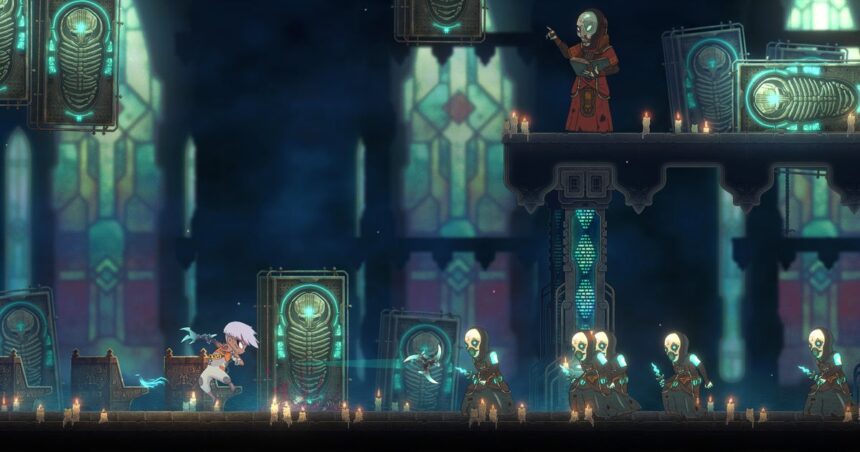Distinguishing one metroidvania from another is a dicey challenge, and not just because there’s a 37.8% chance that saying the word “metroidvania” will cause RPS regular Sin Vega to materialise in the mirror and assassinate you with cheesewire. Metroidvanias stand apart for me only in hindsight – it’s all about the precise ratio of abilities to ability gates, of jump-doublers to overhangs, all things that take time to assess properly. Echo Weaver sets itself apart early, however, by declaring that “time is your currency” and that “when faced with eternity, knowledge is the only gear you need”, a phrase that, admittedly, I would probably have extended to “…oh, and a spacetime-folding glaive that works like a throwable fast travel point”.
“All of the gates, all the progression, all the unlocks – it’s only knowledge,” says Chris Sumsky, one of three developers working on the game at Moonlight Kids. “So everything you can ever do, you already can do, you just don’t know how to do it. If you think like Outer Wilds, or Tunic, or The Witness, where it’s all just secrets and knowledge – it’s that idea merged with platforming, movement tech, speedrunning, things like that.” This is a metroidvania without a progression system and only a smattering of tools with which to thread the inside of a setting that is constantly rewinding itself. I like what I’ve seen of the execution enough that I’m willing to forgive the use of “metroidBRAINia” (apparently it’s an established term?) in the marketing materials. I probably wouldn’t say that one out loud in front of a mirror either. Who knows what kind of cosmic vengeance it might attract.

You might remember Moonlight Kids as the creators of gambolling Pikmin-alike The Wild At Heart, whose enveloping magic forest can still be glimpsed in the new game’s overgrown setting. In Echo Weaver you are the titular Weaver, a clone who wakes at the heart of a lunar colony that has fallen to a mushroom apocalypse, with great pillows and carpets of pastel fungus slowly engulfing a 2D landscape of crackling circuits, spiked walls and sealed doors. It’s like they turned Jeff Vandemeer loose on Sonic’s Scrapyard Zone.
The Weaver is a nimble creature, able to slide, wall-jump and dash, but your forays are constrained by the timeloop, which drops you back at spawn when it hits 0. Making progress is about either adding seconds to that loop – some extensions are permanent, others only last for the duration of the current run – or discovering shortcuts. One of the key shortcuts is that throwable glaive, which you can either teleport to or teleport back to you, allowing you to blink through architecture that might take you a whole 60 seconds to traverse on foot.
Time isn’t only gained, however: certain gates demand a tithe of seconds, for example, and deciding whether to hoard or spend time feeds into a wider background tragedy involving ancient ruins, alien DNA, religious zealots and micro-universes. Sumsky spoiled a little about the loop’s origins during my 20 minutes with the game – I won’t give it away, of course, but suffice to say that it made me sad. There’s a small cast of survivors to discover – including what looks like a grinning mutant cat fungus – whom you might help or save as you unravel the whole.
If Echo Weaver is a tragedy, it’s also a game for everyone. “Our design philosophy is that the game is really accessible to anyone with a passing interest in games,” Sumsky says. “You don’t have to be a hardcore platformer fan to enjoy it and finish the main story”. This agenda notwithstanding, I found the demo reasonably challenging – you have to worry about stuff like poison gas, and there’s the odd precision-wall-jump section that reminds me of Celeste. Without going into detail, Sumsky adds that there are some optional elements and techniques that are more “for the hardcore and for speedrunners out there”: a practised player might “do all kinds of weird tricks to avoid repetition, and just enhance that sense of mastery”.
He adds that it’s been fascinating to explore how a metroidvania works, when you apply a timeloop to it. (Echo Weaver isn’t the first to try this: other examples include Ultros, which Katharine – RPS in peace – reviewed before she abandoned us to go hang with the cool kids at Eurogamer.) “What does that mean, both from the game design point of view and for how the progression works for the player?” Sumsky says. “Because everything resets every loop, and that kind of goes against everything metroidvania stands for in terms of power progression. So it makes for a really interesting challenge. How do you get the same dopamine hit, the same power scaling feeling while also taking everything away from you?”
I feel like Sumsky is blurring the lines a little here with roguelikes, in which abilities and gear have a statistical power curve rather than being keys to problems, as in Metroid. But regardless, I am always intrigued by any game that plays against genre in this way, and I’m intrigued to play more of this.

